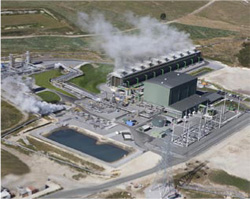Home > Highlighting JAPAN > Highlighting Japan JULY 2011 > Harnessing the World's Geothermal Reserves
Highlighting JAPAN
COVER STORY: Embracing New Energy
Harnessing the World's Geothermal Reserves
Geothermal power generation is increasingly being seen as a viable new energy source. Japanese technology has made significant contributions in the field for which it has garnered global attention. The Japan Journal's Ames Pomeroy reports.

In May 2010, Fuji Electric completed the world's largest single-unit power station for generating geothermal power, in Nga Awa Purua, New Zealand.
Credit: COURTESY OF FUJI ELECTRIC
At present, twenty-four countries including Japan are generating geothermal power. Total capacity for power generation installations is highest in the United States, followed by the Philippines, Indonesia in third place, and Mexico in fourth place. To date, the total global output of geothermal power generation is more than 10,000 MW and total global output for geothermal power will expand further over the next five years.
Japanese technology is involved in the operation of geothermal power installations around the world. More than 70% of geothermal power worldwide is supplied using the equipment of Japanese corporations such as Fuji Electric, Mitsubishi Heavy Industries and Toshiba.
The hot water and steam used to generate geothermal power are not only heated to high temperatures, but also highly pressurized and they contain hydrogen sulfide and other corrosive elements. Therefore, the equipment must be able to withstand both corrosion and fatigue. High durability is a strong point of Japanese corporations.
Expanding the Potential
With developments in geothermal power generation underway worldwide, Fuji Electric completed the world's largest single-unit power station for generating geothermal power, Nga Awa Purua, in New Zealand in May last year. The plant generates 140 MW of power annually, which can cover the needs of about 450,000 households.
Fuji Electric traces the development of the market for geothermal energy back to 1979. It started with the delivery of turbines to a plant constructed in El Salvador as part of a geothermal energy project. Fuji Electric was known as a major geothermal steam turbine generator supplier, mainly in the state of California in the United States, and in the 1990s it transformed itself into a supplier of comprehensive power plants, undertaking geothermal power plants construction worldwide. Fuji Electric accounts for 950 MW, or 45%, of the total output of geothermal power plants built around the world over the past ten years.
Shigeto Yamada, general manager at the Energy Business Headquarter of Fuji Electric comments, "In Iceland, where there are many volcanoes and an abundance of geothermal energy, a quarter of total electricity in the country is provided by geothermal power, making it an advanced country in the field. In Iceland, our company recently announced plans to build a plant to utilize geothermal power generation for aluminum smelters in the future."
In recent years, Iceland has focused on attracting aluminum smelting plants from Europe and welcomed investment from overseas. Large amounts of energy are required for smelting aluminum, but Iceland is importing bauxite, using cheap geothermal and hydroelectric power for smelting, and exporting the aluminum overseas.
The binary power generation system is one of the geothermal energy technologies where Fuji Electric is focusing efforts. By its nature, geothermal power generation uses underground steam at temperatures above 150尊C to turn the turbines to generate power, but by using a fluid with a low boiling point (pentane: boiling point at 36尊C), binary power generation makes it possible to generate power using steam and boiling water at lower temperatures. Binary power generation is in the process of spreading internationally as well. Japan's largest geothermal power station, Hacchoubaru Geothermal Power Station operated by Kyushu Electric Power Company at Sujiyu Hot Spring in western Oita Prefecture in Kyushu, generates 2,000 kW of energy using the binary power generation system.
Yamada comments, "By using this technology, the potential for geothermal power generation will expand even more in the future."
Japan ranks eighth in terms of the total capacity of geothermal power installations, but in terms of exploitable geothermal resource potential, Japan is third after Indonesia and the United States. To date, geothermal energy has been insufficiently utilized because of the high cost and the restrictions on development posed by the location of geothermal resources within national parks. As of this year, however, there are moves underway to utilize geothermal energy in Japan, with the Ministry of the Environment starting to study ways to relax regulations to promote geothermal power generation, and with a decision to begin a survey premised on binary power generation at Oguni-machi in Kumamoto Prefecture in Kyushu in this fiscal year. In addition, the major petroleum companies have announced a joint survey of geothermal power generation in Akita Prefecture and Hokkaido.
© 2009 Cabinet Office, Government of Japan






